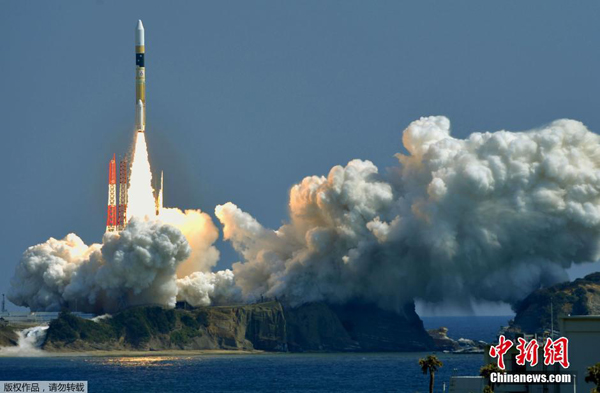Japan launches optical spy satellite
 0 Comment(s)
0 Comment(s) Print
Print E-mail Xinhua, March 26, 2015
E-mail Xinhua, March 26, 2015
Japan on Thursday launched an information-gathering satellite (IGS) with an optical reconnaissance payload on an H-2A rocket, the country's second launch this year.
 |
|
Japan on Thursday launched an information-gathering satellite (IGS) with an optical reconnaissance payload on an H-2A rocket, the country's second launch this year. [Photo/Chinanews.com] |
The Japan Aerospace Exploration Agency (JAXA) and Mitsubishi Heavy Industries, Ltd.-- Japan's space agency and the commercial operator of the H-2A rocket--launched the spy satellite aboard the H-2A Launch Vehicle No.28 at 10:21 a.m. (0121 GMT) on Thursday from JAXA's Tanegashima Space Center in Japan's southwestern Kagoshima prefecture.
About 20 minutes later, JAXA announced the separation of the rocket and the satellite as planned and the satellite successfully entered orbit.
Intelligence satellites are believed to be employed to monitor ground surfaces to gain information related to national security and disasters.
Operated by Japan's Cabinet Satellite Intelligence Center, which reports directly to the government's executive leadership, the country's IGS program consists of optical and radar imaging spacecraft.
Thursday's launch carried the 14th spacecraft in Japan IGS series. It is also the country's fifth launch of satellites in fiscal 2014 (April 1, 2014-March 31, 2015), hitting a record high number in a single fiscal, and only 53 days after Japan launched a backup intelligence satellite on Feb.1, the shortest interval of time ever in the country.
Japan launched a prototype third-generation optical IGS spacecraft in 2013, the operational version of which made debut with Thursday's launch. Thursday's launch carried the first third- generation spacecraft for the series, Optical 5, which will obtain high-resolution images with a telescopic optical camera. The imager's exact capabilities, however, are kept secret by the Japanese government.
According to Japan's Cabinet Satellite Intelligence Center, the development and manufacture cost of Optical 5 reached 32.5 billion yen (about 272.41 million U.S. dollars), while its launch cost hit 10.6 billion yen (about 88.85 million U.S. dollars). The design life of Optical 5 is five years.
Earlier, Japan launched a radar sensor information-gathering satellite on Feb.1, which is equipped with a radar spy instrument capable of peering through clouds, darkness and camouflage to obtain high-resolution imagery of Earth's surface.
Prime Minister Shinzo Abe said in a statement following the launch on Feb.1 that the government will build a reliable system for gathering information in order to boost Japan's national security and enhance its crisis management capabilities.
Information obtained and images captured by the satellites are subject to a law enacted last year to enable the Japanese government to designate information it deems sensitive as state secrets, according to local media.
Up to three more launches from Tanegashima are planned before the end of 2015, according to media reports.
Japan's H-2B rocket is set for lifting off on Aug.17 with a cargo ship for the International Space Station.
Two further H-2A missions are expected to occur towards the end of the year; the first orbiting the New X-ray Telescope (NeXT), also known a ASTRO-H, an international astronomical observatory and the second carrying Telstar-12V, the first commercial communications satellite to be launched aboard a Japanese rocket.






Go to Forum >>0 Comment(s)